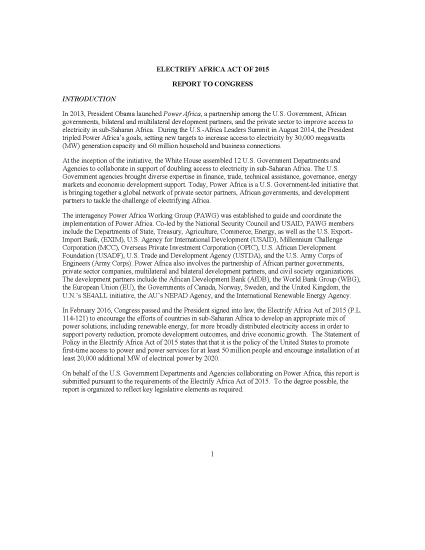In 2013, President Obama launched Power Africa, a partnership among the U.S. Government, African governments, bilateral and multilateral development partners, and the private sector to improve access to electricity in sub-Saharan Africa. During the U.S.-Africa Leaders Summit in August 2014, the President tripled Power Africa’s goals, setting new targets to increase access to electricity by 30,000 megawatts (MW) generation capacity and 60 million household and business connections.
At the inception of the initiative, the White House assembled 12 U.S. Government Departments and Agencies to collaborate in support of doubling access to electricity in sub-Saharan Africa. The U.S. Government agencies brought diverse expertise in finance, trade, technical assistance, governance, energy markets and economic development support. Today, Power Africa is a U.S. Government-led initiative that is bringing together a global network of private sector partners, African governments, and development partners to tackle the challenge of electrifying Africa.
The interagency Power Africa Working Group (PAWG) was established to guide and coordinate the implementation of Power Africa. Co-led by the National Security Council and USAID, PAWG members include the Departments of State, Treasury, Agriculture, Commerce, Energy, as well as the U.S. Export-Import Bank, (EXIM), U.S. Agency for International Development (USAID), Millennium Challenge Corporation (MCC), Overseas Private Investment Corporation (OPIC), U.S. African Development Foundation (USADF), U.S. Trade and Development Agency (USTDA), and the U.S. Army Corps of Engineers (Army Corps). Power Africa also involves the partnership of African partner governments, private sector companies, multilateral and bilateral development partners, and civil society organizations. The development partners include the African Development Bank (AfDB), the World Bank Group (WBG), the European Union (EU), the Governments of Canada, Norway, Sweden, and the United Kingdom, the U.N.’s SE4ALL initiative, the AU’s NEPAD Agency, and the International Renewable Energy Agency.
In February 2016, Congress passed and the President signed into law, the Electrify Africa Act of 2015 (P.L. 114-121) to encourage the efforts of countries in sub-Saharan Africa to develop an appropriate mix of power solutions, including renewable energy, for more broadly distributed electricity access in order to support poverty reduction, promote development outcomes, and drive economic growth. The Statement of Policy in the Electrify Africa Act of 2015 states that that it is the policy of the United States to promote first-time access to power and power services for at least 50 million people and encourage installation of at least 20,000 additional MW of electrical power by 2020.
On behalf of the U.S. Government Departments and Agencies collaborating on Power Africa, this report is submitted pursuant to the requirements of the Electrify Africa Act of 2015. To the degree possible, the report is organized to reflect key legislative elements as required.








Comment
Make a general inquiry or suggest an improvement.